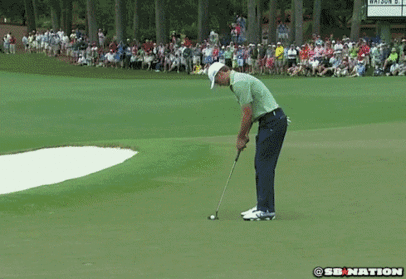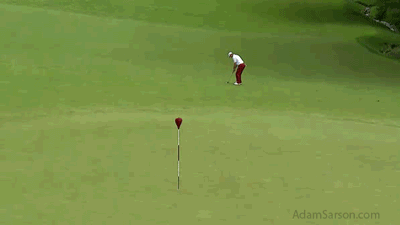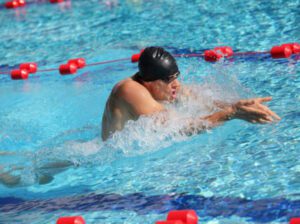How To Use Breaking Putts Effectively
Many beginner or amateur golfers get caught up in the big thrill of driving a ball hundreds of yards downfield, or, if not that, the meticulous approach of reaching the green. But once they get to the pin, their game takes a major drop-off and scores inflate quicker than a hot air balloon. For any aspiring golfer, their ability to read the green and react appropriately is absolutely crucial towards taking their next step.
Not only must a golfer get the ball in the hole, accounting for wind, speed, and power, but they also need to be in tune with the green. Of course, reading the can be tricky — Will it go left? Right? Is there a slope? So, in order to improve, it often boils down to practice, practice, and more practice! Try to take these putts from different ranges across the green. The more angles and distances you feel comfortable with, the more likely you’ll be to nail a big putt when it matters most. CoachUp has put together a small list of tips to master the breaking putt, so use them to your advantage the next time you’re out on the course!

Ignore the Cup
Yes, that’s right! In order to be better at putting the ball in the cup, you need to forget about the cup altogether. It may sound completely ridiculous, but give it a try. Most players get caught up with the desired end result of a putt that they don’t focus on the first 90% of the stroke. Try focusing on everything around the cup instead — figuring out how the ball will break is far more important than the hole more often than not.
Tee It Up
From here on out, your tees will become your best friend on the course. Find a cup on the practice green that has the most slope directly around the hole. Place a tee adjacent to the hole on the side the ball will break on. For example, if the putt has six feet of break from right to left, put a tee six feet from the right of the hole.
These tees will allow you to focus on the task at hand, which is the break, not the hole. Try to forget about putting the ball in the hole at all during this exercise — that isn’t the goal. The goal is to better understand the slopes, hills, and breaks that silently assassinate scores in the blink of an eye. Slowly find out what works in terms of putt speed, angle, and distance, it will be a constant game of trial and error.

Improvement Comes In All Shapes and Sizes
For most athletes, improvement comes in conjunction with touchdowns, three-pointers, or a personal record — but for golfers, the small details can matter even more. In a practice context, it is far better to struggle and make mistakes while learning than it is to just breeze through a green without much thought. That scenario might end with a lucky putt or good approach for no other reason but chance. However, you might not be so fortunate during a tournament. Don’t cut corners!
Remember, the object is to focus on your target is the tee, not the hole. This is absolutely crucial because athletes trick themselves into thinking that improvement comes with points or a lower score, but that, sometimes, can be the furthest from the truth. Try to meticulously work through holes and not worry about the number of strokes it takes to finish. In the grand scheme of things, taking an extra few strokes during practice is much preferred to even needing one more during a tournament. When there are actual stakes on the line, any golfer should relish in their extra practice opportunities.
The Brain Game
Believe it or not, your brain can undoubtedly and unconsciously influence your shots in ways you didn’t think were possible. It’s important to remember that brains are conditioned to work a certain way, usually towards a goal or reward, especially when in a competitive sports context. Typically, an untrained brain will immediately analyze the situation and determine finishing the hole is the ultimate end game; and, even if you don’t realize it, will influence your shot before you even line up for it.
In addition, novice golfers can make unconscious mistakes by looking at the hole, then the target tee, and then back at the hole. Often enough, brains will process your last target as the objective and desired destination. So, in this case, the brain wants to aim towards the hole even despite your efforts not to. Now, unfortunately, the putt starts at the hole instead of the tee. The result is often disastrous, with the ball missing on the low side of a hole. At that point, players will say they pulled it when, in reality, they probably just started on the wrong target in the first place. It’s a tough obstacle to overcome because it’s done so effortlessly in your subconscious, but golfers need to start mentally training themselves for these situations.
Going With The Grain
In the simplest of terms, the grain is the way the grass lies on the green. Although it seems minuscule and tiny, the distances you’ll end up missing the cup by are much larger. So pay attention to what’s in front you! You wouldn’t want to drive a car without knowing if the brakes worked properly, right? Well, the same applies here and you shouldn’t take a putt without knowing what lies in front of you! Without that knowledge, a ball might suddenly slow down or speed up for no reason, leaving you with a wasted stroke and major frustration.
If the green is somewhat flat, the grass will typically grow towards the west and the setting sun. If there is a substantial slope, the grain will grow to the direction in which water would theoretically flow. On long putts with a lot of break, the ball will only be changed by the grain on the last third of the putt as it loses speed. Ultimately, the grain and slope will have the most influence on the ball, so make sure you do your homework.
(Related: Read some putting tips here.)
Huddle Up
You might not have even realized the impact of a break on your putts, but they can be a killer if you’re not paying attention. Learning how to use the break to your advantage can be incredibly frustrating, especially at the expense of potentially forfeiting your score during practice, However, remember that no one hole is the same, so it might be maddening during practice, but you’ll be ready for any scenario when the opportunity comes.
But if you’re still struggling with reading the green, consider booking a private training from CoachUp. There are plenty of trainers that would to love help you get more comfortable behind the putter, so consider reaching out today! What are you waiting for?
How useful was this post?
Click on a star to rate it!
Average rating 0 / 5. Vote count: 0
No votes so far! Be the first to rate this post.



